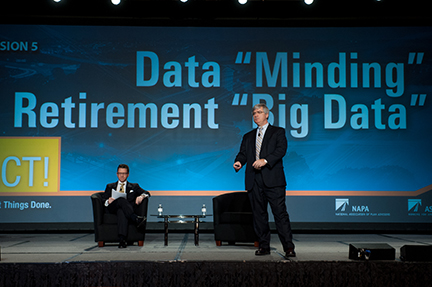ASPPA News from the Field
2013 NAPA/ASPPA 401(k) SUMMIT
 LAS VEGAS (March 5, 2013)—At this year’s NAPA/ASPPA 401(k) SUMMIT, Nevin Adams of the Employee Benefit Research Institute, and Douglas Fisher of Fidelity Investments presented thought-provoking ideas on interpreting and utilizing the large amount of data on private retirement plans available in order to encourage better retirement outcomes. With more than 25 years of data to “mind,” Adams explained that advisors face the challenge of understanding the data and data sources: to recognize misunderstood or misapplied data, good data, and good data gone bad.
LAS VEGAS (March 5, 2013)—At this year’s NAPA/ASPPA 401(k) SUMMIT, Nevin Adams of the Employee Benefit Research Institute, and Douglas Fisher of Fidelity Investments presented thought-provoking ideas on interpreting and utilizing the large amount of data on private retirement plans available in order to encourage better retirement outcomes. With more than 25 years of data to “mind,” Adams explained that advisors face the challenge of understanding the data and data sources: to recognize misunderstood or misapplied data, good data, and good data gone bad.
Adams provided several examples of typical myths repeated in the retirement industry that are debunked by breaking down the data, such as, “Not so long ago, people worked for a single employer their entire career,” or “Only about half of working Americans are covered by a workplace retirement plan.” However, data collected on the median tenure for male workers between the ages of 25-64 from 1951 to 2010 indicates that workers enjoyed a relatively steady tenure from 1951 up until 2010. When you break down the data regarding workers covered by a workplace retirement plan, you find categories of employees overlapping so that the results actually indicate that two thirds of Americans workers are covered by a workplace plan instead of only half.
Another example the panelists gave to show the value of analyzing data appropriately involved the effectiveness of auto enrollment. In one study, plans offering auto enrollment were tied to lower match rates than plans that were not offering auto enrollment. Research from the nonpartisan Employee Benefit Research Institute contradicted these results by concluding the opposite: showing higher match rates for large plan sponsors implementing auto enrollment, and pointing out the errors in the conclusions of the prior study.
An employer’s size and demographics are important when collecting good data and making conclusions about the data. Adams summarized this concern: “Know the source, know your source’s source, watch out for ‘spliced’ data, and just because it confirms what you think, doesn’t mean it is right.”
Next, Fisher addressed how big data can drive better retirement outcomes and government policies. He offered, “We are all stewards of the retirement industry—plan sponsors, advisors, record-keepers and consultants. Collectively, we own the solutions to the future of retirement—that is what participants expect from us.”
Fisher suggested that workers invest time in understanding how their workplace savings, private pensions, social security and other personal savings translate into a “paycheck” in retirement. A general rule of thumb for many savers is to plan for income replacement in retirement of at least 85% of your final salary—keeping in mind there are many variables that can increase or decrease this basic amount. Pointing out that people are living longer and that 41% of lower income households will run out of their savings within 10 years of retirement, Fisher believes that policy makers will begin to address this issue, among others, in the next major retirement reform proposal.
Fisher also suggested that auto enrollments did “tremendous things” to increase employee participation levels and is one of the “greatest innovations in the last 20 years” in the retirement industry.
Fisher encouraged advisors to come up with a “benefit strategy” that drives better retirement outcomes for employees. He suggested getting sponsors to increase benefits, see if plan changes could encourage employees to participate, and strategizing with sponsors on “where they want the employee on the line of savings.” To encourage better results, Fisher also suggested that advisors become more familiar with the Saver’s Credit and catch-ups.
Advisors don’t know what’s going on with the success of their plans when they don’t apply lessons gleaned from the metrics available. Fisher recommended that advisors get data from record-keepers, “become an advocate in outcomes,” and “talk with plan sponsors.” In general, it should be the employer’s strategy to get employees’ savings to the highest possible level to prepare them for a dignified retirement.
 -Reba Cardillo, ERPA, QPA, QKA
-Reba Cardillo, ERPA, QPA, QKA
Principal, Southern Pension Services
ASPPA Member Since 1997
Mind the Data to Improve Participant Outcomes #EBRI #retirement #401k http://t.co/x0IP4jru6s
RT @nevinesq: Mind the Data to Improve Participant Outcomes #EBRI #retirement #401k http://t.co/x0IP4jru6s
At #401kSUMMIT Douglas Fisher and @nevinesq discussed how big data can help improve participant outcomes #retirement http://t.co/dXD6yLZKcL
At #401kSUMMIT Douglas Fisher and @nevinesq discussed how big data can help improve participant outcomes #retirement http://t.co/mG8ctDfNV1
RT @ASPPA: At #401kSUMMIT Douglas Fisher and @nevinesq discussed how big data can help improve participant outcomes #retirement http://t …
RT @ASPPA: At #401kSUMMIT Douglas Fisher and @nevinesq discussed how big data can help improve participant outcomes #retirement http://t …
RT @ASPPA: At #401kSUMMIT Douglas Fisher and @nevinesq discussed how big data can help improve participant outcomes #retirement http://t …
RT @ASPPAMedia: At #401kSUMMIT Douglas Fisher and @nevinesq discussed how big data can help improve participant outcomes #retirement htt …
Mind the Data to Improve Participant Outcomes - http://t.co/V5Tp7QjHZM
RT @401khelpcenter: Mind the Data to Improve Participant Outcomes - http://t.co/V5Tp7QjHZM
RT @401khelpcenter: Mind the Data to Improve Participant Outcomes - http://t.co/V5Tp7QjHZM
How big data can help improve participant outcomes in #retirement: http://t.co/cUTWG8mQW1 RT @ASPPA #401kSUMMIT
RT @KravitzInc: How big data can help improve participant outcomes in #retirement: http://t.co/cUTWG8mQW1 RT @ASPPA #401kSUMMIT